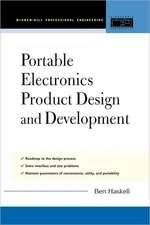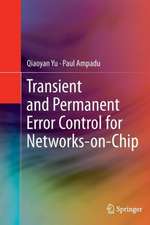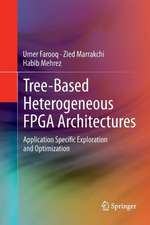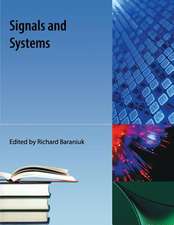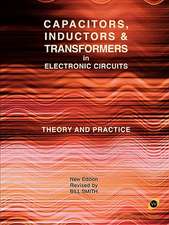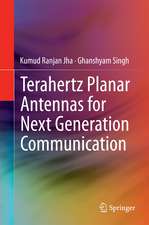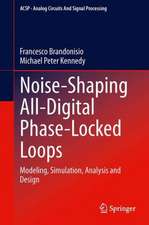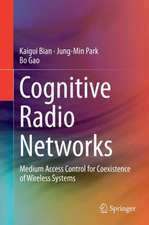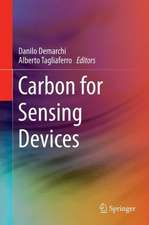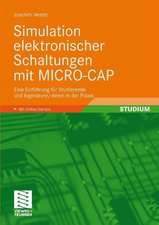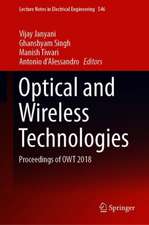Spectrum Sharing in Cognitive Radio Networks: Medium Access Control Protocol Based Approach
Autor Shweta Pandit, Ghanshyam Singhen Limba Engleză Hardback – 24 apr 2017
| Toate formatele și edițiile | Preț | Express |
|---|---|---|
| Paperback (1) | 639.59 lei 6-8 săpt. | |
| Springer International Publishing – 21 iul 2018 | 639.59 lei 6-8 săpt. | |
| Hardback (1) | 645.79 lei 6-8 săpt. | |
| Springer International Publishing – 24 apr 2017 | 645.79 lei 6-8 săpt. |
Preț: 645.79 lei
Preț vechi: 759.76 lei
-15% Nou
Puncte Express: 969
Preț estimativ în valută:
123.59€ • 134.20$ • 103.81£
123.59€ • 134.20$ • 103.81£
Carte tipărită la comandă
Livrare economică 23 aprilie-07 mai
Preluare comenzi: 021 569.72.76
Specificații
ISBN-13: 9783319531465
ISBN-10: 3319531468
Pagini: 247
Ilustrații: XXIII, 254 p. 81 illus., 58 illus. in color.
Dimensiuni: 155 x 235 x 18 mm
Greutate: 0.57 kg
Ediția:1st ed. 2017
Editura: Springer International Publishing
Colecția Springer
Locul publicării:Cham, Switzerland
ISBN-10: 3319531468
Pagini: 247
Ilustrații: XXIII, 254 p. 81 illus., 58 illus. in color.
Dimensiuni: 155 x 235 x 18 mm
Greutate: 0.57 kg
Ediția:1st ed. 2017
Editura: Springer International Publishing
Colecția Springer
Locul publicării:Cham, Switzerland
Cuprins
Cognitive Radio Communication System¾Spectrum Sharing Techniques.- Spectrum Sensing in Cognitive Radio: Potential Techniques and Future Perspective.- Medium Access Control Protocol for Distributed Cognitive Radio Network.- Distributed Cognitive Radio Medium Access Control Protocol in Perfect and Imperfect Channel Sensing Scenarios.- Throughput Enhancement using Bandwidth Wastage in MAC Protocol of the Distributed Cognitive Radio Network.- Power Allocation for Optimum Energy Efficiency in MAC Protocol of Cognitive Radio Communication System.- Frame Structure for Throughput Maximization in Cognitive Radio Communication.- Capacity Limits over Fading Environment with Imperfect Channel State Information for Cognitive Radio Network.- Channel Capacity of Cognitive Radio in Fading Environment with CSI and Interference Power Constraints.- Framework for Cross-Layer Optimization in Cognitive Radio Network.
Notă biografică
Shweta Pandit has received B. Tech. (Honours) degree from Himachal Pradesh University, Shimla, India in 2010. She also received M. Tech. and Ph D degree in Electronics and Communication Engineering from the Department of Electronics and Communication Engineering, Jaypee University of Information Technology, Waknaghat, Solan, India in 2012 and 2015, respectively. Currently, she is working as Assistant Professor in the Department of Electronics and Communication Engineering, Jaypee University of Information Technology, Waknaghat, Solan, India. Her area of research interests is next generation communication system, cognitive radio, wireless network, and capacity enhancement and interference reduction in wireless channel.
Professor G. Singh received PhD degree in Electronics Engineering from the Indian Institute of Technology, Banaras Hindu University, Varanasi, India, in 2000. He was associated with Central Electronics Engineering Research Institute, Pilani, and Institute for Plasma Research, Gandhinagar, India, respectively, where he was Research Scientist. He had also worked as an Assistant Professor at Electronics and Communication Engineering Department, Nirma University of Science and Technology, Ahmedabad, India. He was a Visiting Researcher at the Seoul National University, Seoul, South Korea. At present, he is Professor with the Department of Electronics and Communication Engineering, Jaypee University of Information Technology, Wakanaghat, Solan, India. He is an author/co-author of more than 200 scientific papers of the refereed Journal and International Conferences. His research and teaching interests include RF/Microwave Engineering, Millimeter/THz Wave Antennas and its Applications in Communication and Imaging, Next Generation Communication Systems (OFDM and Cognitive Radio), and Nanophotonics. He has more than 14 years of teaching and research experience in the area of Electromagnetic/Microwave Engineering, Wireless Communication and Nanophotonics. He has supervised various Ph. D. and M. Tech. theses. He has worked as a reviewer for several reputed Journals and Conferences. He is author of two books “Terahertz Planar Antennas for Next Generation Communication” and “MOSFET Technologies for Double-Pole Four-Throw Radio-Frequency Switch” published by Springer.
Professor G. Singh received PhD degree in Electronics Engineering from the Indian Institute of Technology, Banaras Hindu University, Varanasi, India, in 2000. He was associated with Central Electronics Engineering Research Institute, Pilani, and Institute for Plasma Research, Gandhinagar, India, respectively, where he was Research Scientist. He had also worked as an Assistant Professor at Electronics and Communication Engineering Department, Nirma University of Science and Technology, Ahmedabad, India. He was a Visiting Researcher at the Seoul National University, Seoul, South Korea. At present, he is Professor with the Department of Electronics and Communication Engineering, Jaypee University of Information Technology, Wakanaghat, Solan, India. He is an author/co-author of more than 200 scientific papers of the refereed Journal and International Conferences. His research and teaching interests include RF/Microwave Engineering, Millimeter/THz Wave Antennas and its Applications in Communication and Imaging, Next Generation Communication Systems (OFDM and Cognitive Radio), and Nanophotonics. He has more than 14 years of teaching and research experience in the area of Electromagnetic/Microwave Engineering, Wireless Communication and Nanophotonics. He has supervised various Ph. D. and M. Tech. theses. He has worked as a reviewer for several reputed Journals and Conferences. He is author of two books “Terahertz Planar Antennas for Next Generation Communication” and “MOSFET Technologies for Double-Pole Four-Throw Radio-Frequency Switch” published by Springer.
Textul de pe ultima copertă
This book discusses the use of the spectrum sharing techniques in cognitive radio technology, in order to address the problem of spectrum scarcity for future wireless communications. The authors describe a cognitive radio medium access control (MAC) protocol, with which throughput maximization has been achieved. The discussion also includes use of this MAC protocol for imperfect sensing scenarios and its effect on the performance of cognitive radio systems. The authors also discuss how energy efficiency has been maximized in this system, by applying a simple algorithm for optimizing the transmit power of the cognitive user. The study about the channel fading in the cognitive user and licensed user and power adaption policy in this scenario under peak transmit power and interference power constraint is also present in this book.
Caracteristici
Provides a comprehensive review of spectrum sensing and sharing techniques; Describes a method using medium access control (MAC) protocol for distributed cognitive radio networks, in perfect and imperfect channel sensing scenarios, to share the primary user’s spectrum; Presents a method to enhance throughput using bandwidth wastage and an approach to allocate power for energy efficiency; Includes a cognitive radio user frame-structure to reduce data loss rate and maximize throughput; Comprises adaptation policies for spectrum sharing in cognitive radio such as power and rate adaptation in fading environment; Outline cross-layer optimization work related to wireless and cognitive radio network. Includes supplementary material: sn.pub/extras

